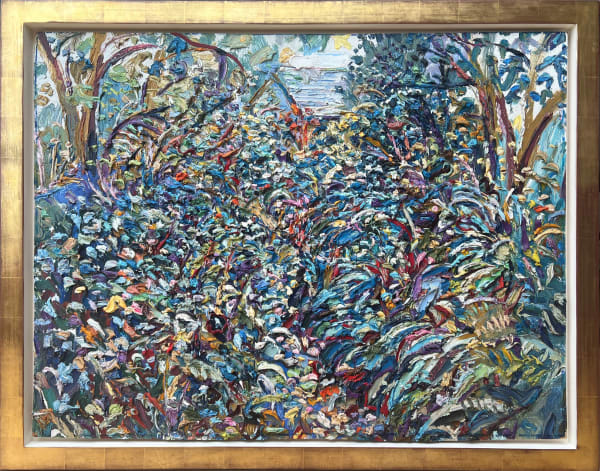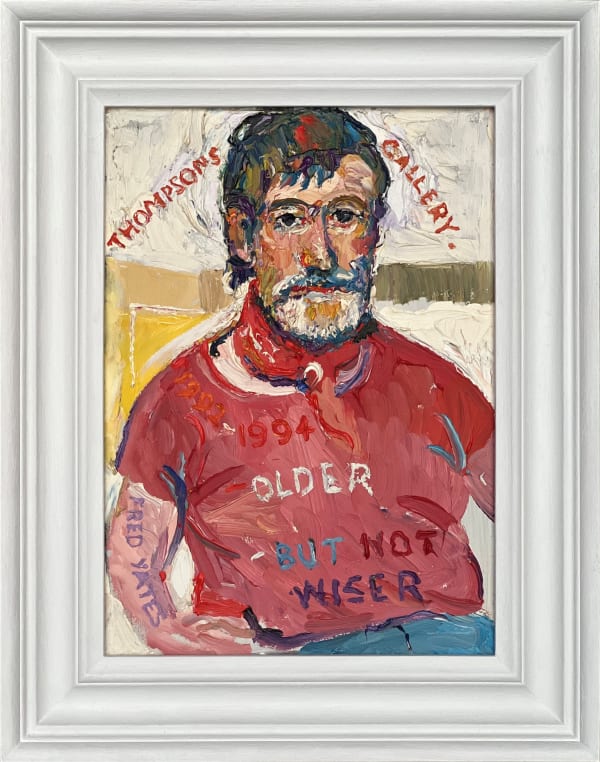Fred Yates paintings for sale
-
 Fred YatesThe Sea GlimpseOil on board81 x 107cm (31¾ x 42 ins.)
Fred YatesThe Sea GlimpseOil on board81 x 107cm (31¾ x 42 ins.)
Framed: 92.8 x 118.4cm (36 x 46⅔ ins.)View full details -
 Fred YatesSt Ives Porthminster BeachOil on canvas61 x 76.2cm (24 x 30 ins.)
Fred YatesSt Ives Porthminster BeachOil on canvas61 x 76.2cm (24 x 30 ins.)
Framed: 74.4 x 89.2cm (29.3 x 35.1 ins.)View full details -
 Fred YatesSelf-portrait, 1994Oil on board38.7 x 27.9 cm (15 ¼ x 11 ins.)
Fred YatesSelf-portrait, 1994Oil on board38.7 x 27.9 cm (15 ¼ x 11 ins.)
Framed: 51 x 40.5 cm (20 x 15 15/16 ins.)
View full details -
 Fred YatesStill Life over RiverOil on canvas50.2 x 61 cm (19 1/4 x 24 ins.)
Fred YatesStill Life over RiverOil on canvas50.2 x 61 cm (19 1/4 x 24 ins.)
Framed: 66 x 77 cm (26 x 30 5/16 ins.)View full details
Like his Manchester stablemate, LS Lowry, Fred’s paintings combine sharp, and disarmingly honest observations of people going about their daily lives with bold, expressive brushwork but also in Fred's case, an explosion of colour: "It is the man in the street that I'm after, whom I feel closest to, with whom I want to make friends and enter into confidence and connivance, and he is the one I want to please and enchant by means of my work".
Frederick Joseph Yates was born in 1922 in Urmston, a town in Trafford, Greater Manchester, one of twin brothers. His father was an insurance agent and Fred had a very traditional, quite disciplined, and rigid up-bringing.
When Fred left school, he took up an administrative role in one of Manchester’s Foundation schools. A measure of the lack of parental encouragement that Fred received is recounted by John Martin (Fred’s long-time dealer and principal representative during Yates's life at the John Martin Gallery in London) in Fred Yates. ‘C’est votre passion, Monsieur’. Fred, looking out the window one day, saw an artist in corduroy trousers. Wanting to emulate him he went straight out and bought a pair. At home that evening his father sent him out of the room saying, “have we got a workman in the house?”
In 1941 Fred joined the Grenadier Guards and served with them until the end of the war. He joked about being on duty at Windsor Castle with the young Princess Margaret making him repeatedly present arms for her innocent amusement by walking backwards and forwards in front of the young guardsman. But the war also heralded a great change in Yates. His twin brother was posted missing in action during the failed attempt to capture the bridge at Arnhem during Operation Market Garden in September 1944.
The tragic and premature loss of his twin had a profound effect upon Fred leaving him with a lifelong apprehension about close relationships. Some of his larger paintings, picture amongst the host of characters, 2 small boys often up to high jinks; a means for Fred to keep his twin bother ever present.
When Fred returned to Manchester after the war, he was determined to follow his heart and pursue painting. With a serviceman’s grant he enrolled in Bournemouth Teacher Training College and worked at a variety of schools over the next 2 decades, giving him time and space to mature as an artist. Success was hard won but whilst his mother was still alive, he had a painting exhibited in the Paris Salon and in 1954, a painting he entered in the Football Association’s Football and Art National Competition came second to no less than Lowry’s masterpiece, Going to the Match. Yates' submission, Brighton and Hove Albion Football Club, is now in the collection of Brighton Museum and Art Gallery. Lowry, famously a fellow Manchester artist, was undoubtedly the artist Yates most admired and was inspired by.
Like Lowry, Fred set out to paint pictures about the lives of ordinary people: " ... It is the man in the street that I'm after, whom I feel closest to, with whom I want to make friends and enter into confidence and connivance, and he is the one I want to please and enchant by means of my work".
In the mid-Sixties Yates commenced his trips to the South of France and in 1969 he abandoned teaching and moved to Cape Cornwall to dedicate the rest of his life to his art. Soon he was offered a one-man show in Geneva at which Henri Cartier-Bresson notably bought a painting.
With no money to spare, most Yates's early works in Cornwall were painted on rough hardboard, sometime even just cardboard, employing household paints. Many of these works have a limited monochrome palette. But Fred’s approachable style won over some notable early collectors. In 1976 he had his first solo show at the Reynolds Gallery in Plymouth and in the same year he was a finalist in the John Moore’s Prize. Throughout the 1970s and 80s Yates’s public and critical acceptance grew and was confirmed by his inclusion in the 1985 exhibition, St Ives 1939–64 at the Tate in London. This was followed in 1992 with Fred’s first solo London exhibition, at the Thompson’s Gallery.
In the early 1990s the artist moved to France, first to a mill house near Beaume De Venise, then to the village of Rancon in the Haute-Vienne, where he continued to boldly and colourfully capture the local landscape and its inhabitants, embracing the unquestioning acceptance of the local people and somewhat better weather than Manchester or even Cornwall. Fred never stayed put for long and from Rancon moved to Sablet in Provence, then Nyons and finally the mountain village of La Motte in the Rhône-Alpes. It was during this period that Yates began to produce some of his most daring paintings, often working with huge quantities of paint applied by stick or hands. There is an anecdotal story that upon entering a new French town or village, Fred would seek out the local art supplier and buy the entire stock of tubes of oil paint, such was his need! And moreover, his late found success afforded the generousity of paint, which was by now, usually applied to more expensive stretched canvases.
In France Fred wrote revealingly about his artistic development, “I now have to establish myself as ‘Fred Yates’ and not Lowry or a primitive or pseudo-primitive. I’m going ‘somewhere’ but I never have a goal. I try very much to be Fred Yates but it’s strange at the moment. I do a painting and my friends love it and it’s just like a Bonnard. I do another painting, and someone says Gauguin, another Van Gogh, very often Dufy. But the incredible thing is that all in all, if they were all put together on a wall, they have one unity, COLOUR! Someone used a ‘weather’ word the other day – amelioration – and it seems to apply to my paintings. A lovely word. Here I am like a tree. Part of the landscape. No-one tells a tree what to do; a tree doesn’t change its character, but it glows with seasonal change like a mannequin in a new dress, and yet it is always the same tree because its structure is there”.
In his final years Fred made repeated efforts to return to England, eventually finding a small house in Frome, Somerset. It was on his journey to complete on the purchase that he fell and suffered a heart attack. Fred Yates died on 7th July 2008 in University College Hospital and is buried in Marazion graveyard overlooking St Michael's Mount, a subject he often painted.
In 2022-23 Penlee House Gallery held a major retrospective and celebration of Yates's work marking the centenary of his birth.
Fred Yates's paintings can be found in the permanent collections of many public galleries and institutions including Brighton and Hove Art Gallery, Liverpool University, the University of Warwick, Torquay Art Gallery and the Russell Coates Gallery in Bournemouth. Fred’s works are joyous, colourful celebrations of people going about their daily lives. To the end the artist sharply observed their relationships and the environments they lived and played in.
Fred Yates, John Martin, Francis Mallet, Fred Yates: C'est votre passion, monsieur! London, White Lane Press, 2007.
Escape to Cornwall, John Martin, "Different Ways of Seeing: The Artistic Visions of Joan Gillchrest, Bryan Pearce and Fred Yates" Axten, Janet. Penlee House Gallery. Publisher Sansom and Co. 2011.






